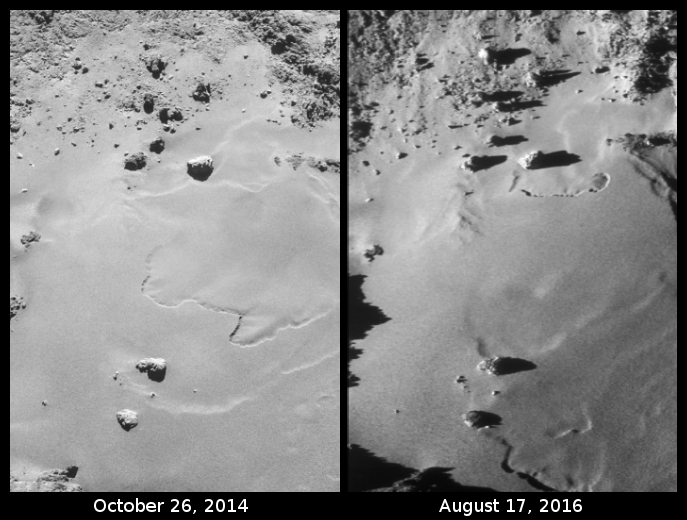Changes on Comet 67P/C-G
Cool image time! Below the fold are two images taken by Rosetta of the smooth boulder-strewn area on Comet 67P/C-G called Imhotep, which has been featured many times by the Rosetta science team. The image on the left was taken October 26, 2014 soon after the spacecraft’s arrival at the comet. The image on the right was taken August 17, 2016, almost two years later after it had completed its close approach to the Sun. With both images I have cropped them and reduced their resolution to fit here. With the more recent image I have also stretched it horizontally to better match it to the older image.
The point? The giant boulders on this smooth region act as markers so that we can more easily compare the region and see how it has changed with time. The newer image clearly shows a loss of material from the surface, with the depressions in the smooth areas having grown much larger and in some areas much deeper. At the same time, there has been a softening in some of the edges between the lower and higher areas, especially in the middle of the smooth region.
What will happen here in the future? It appears that the smooth area is actually pond of dust that is slowly evaporating away with each close approach to the Sun, leaving behind the solid bedrock pinnacles within it that only appear as boulders because they are mostly buried. Eventually, when the dust is gone, some of those pinnacles will break away as well.

On Christmas Eve 1968 three Americans became the first humans to visit another world. What they did to celebrate was unexpected and profound, and will be remembered throughout all human history. Genesis: the Story of Apollo 8, Robert Zimmerman's classic history of humanity's first journey to another world, tells that story, and it is now available as both an ebook and an audiobook, both with a foreword by Valerie Anders and a new introduction by Robert Zimmerman.
The print edition can be purchased at Amazon or from any other book seller. If you want an autographed copy the price is $60 for the hardback and $45 for the paperback, plus $8 shipping for each. Go here for purchasing details. The ebook is available everywhere for $5.99 (before discount) at amazon, or direct from my ebook publisher, ebookit. If you buy it from ebookit you don't support the big tech companies and the author gets a bigger cut much sooner.
The audiobook is also available at all these vendors, and is also free with a 30-day trial membership to Audible.
"Not simply about one mission, [Genesis] is also the history of America's quest for the moon... Zimmerman has done a masterful job of tying disparate events together into a solid account of one of America's greatest human triumphs."--San Antonio Express-News


Where the crust is thin enough, and enough exposed to sunshine during the orbital seasons and rotational period, the subsurface volatiles are being boiled until they break out in a burst. The volatiles evaporate and leave the comet while the remaining dust slowly rains down to form such dust ponds. Almost like sand dunes shaped by an atmospheric wind. Because of the milligravity environment, boulders are dust covered blocks of ices which form by being thrown out from the boiling subsurface during such bursts. The comet accumulates a thicker and thicker cover of dust while the volatiles below the surface boil off out of different hot spots. Finally, the dust cover will isolate the entire surface from heating and stop any further outbursts. Until the comet passes nearby Jupiter again and reduces its orbit’s perihelion, like it did as late as in the 1950s, which has reactivated the comet since then. It is transformed into a block of mixed ices covered by a pitch black crust of non-volatile materials.
Picking up one of those fluffy ice boulders would turn it into a tiny comet that boils from within and spews out dust and gravel as it is exposed to Sunlight from earlier shadowed angles. Astronauts could get surprised if dealing with it manually. Pockets of volatiles inside of it would form bubbles of vapor that burst out of the shell for a few seconds to minutes. I suppose most asteroids were formed dry inside of the frost line, which the Main Belt happens to straddle, while others are inactivated comets with a highly volatile but thermally isolated core and mantle after having formed in the icy outer Solar System.
To mine a comet, one just puts a heated tube through its fluffy surface dust and it will be like an oil gusher. Extracted from the inside like a drilled oil well, rather than doing open pit mining.
You may well be correct on all points. I’m guessing its the asteroid miners who will find out first.